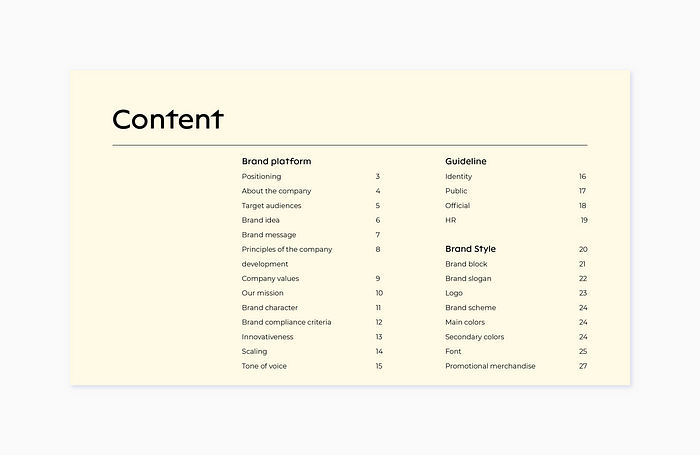Brand Book & GuidelineHow to create a brilliant identity and improve the brand image

“Brand book? Why do I need it? — says the owner of a small company indifferently. — I have a small business. I have a logo, what else do I need? I don’t need any brand book.”
Their business is highly likely to remain small if one day it does not disappear completely. This entrepreneur doesn’t really know what a brand book is and why it’s useful. Perhaps they lack strategic thinking or don’t believe that the brand book will help their small company to push on to the next level. Someone told them that only large companies need a brand book.
Why do you need a brand book?
A brand book is a document that contains the main values and principles of a company as well as brand identity guidelines. Those who are interested in developing and promoting their business need a brand book like air — regardless of the size of their company.
The brand book is called the “Brand Bible”, which speaks of its importance. It contains all the important information about the brand: a description of values, philosophy, methods of the positioning of the company, development strategies. In the process of its creation, you structure information, identify problematic and missed points, and most importantly — you get a holistic vision of the brand and its positioning. Many entrepreneurs literally “unclose their eyes” when working on a brand book. They are seized with new ideas, find a vision of the prospects for their business.
These wonderful discoveries won’t happen if you instruct someone to create a brand book but wouldn’t participate in it personally. The best solution is teamwork with good feedback between you and the performer.
Goals of a brand book
A brand book is needed not only within the company. It can be useful to your clients and business partners, as well as designers for further work.
Main goals of a brand book:
- systematization of brand information in one document;
- informing employees about the goals of the brand and its mission;
- increasing the effectiveness of marketing activities;
- assistance in creating the brand image and reputation;
- standardization of the usage process of the corporate identity elements.
 Clover brand guidelines
Clover brand guidelines
A professionally made and beautiful brand book motivates the company’s employees to become involved with the brand and its philosophy so much that the brand’s mission turns into a personal one.
A visual implementation of the brand’s values motivates people to trust it.
Brand book structure
A brand book usually has three parts: ideological, visual, and legal.
The ideological part gives answers to basic questions: what is your brand, for whom it was created, what is its mission, and how the brand communicates with the consumers.
The visual and communicative part is a graphic implementation of the ideological one. Here you regulate exactly how, with the help of what signs, symbols, and words your brand should convey to consumers the key brand values. For the technical description of corporate identity elements, a guideline is created. It can be either part of the brand book or an independent document.
Legal part. The documents governing the company’s author’s rights are listed here. The brand’s platform is the basis of the brand book, its semantic core. This is a structured description of the key components of positioning. It includes market audit, product audit, target audience analysis, competitor analysis, USP (unique selling proposition), and RTB of the brand (reason to believe).
The brand’s platform is the basis of the brand book, its semantic core. This is a structured description of the key components of positioning. It includes market audit, product audit, target audience analysis, competitor analysis, USP (unique selling proposition), and RTB of the brand (reason to believe).
The text of the “semantic core” must be formulated lucidly and simply, emotionally strongly, clearly and beautifully. This is particularly true for the formulation of a business idea, slogan, and motto of the company.
The impression of the most beautiful meaning can be destroyed by a bad visual, so the work on the brand book design should be entrusted to professionals only.
Main elements of the brand book
1. Cover
It declares the brand and demonstrates the most recognizable elements of the corporate identity — the logo, colors, and fonts. Design by Outcrowd
Design by Outcrowd
2. Content
Regardless of the number of pages in the book, it should be easy and convenient to navigate through it. The content of the electronic version should remain on the screen while you scroll through the brand book.
The possible content of the brand book can be as follows: The inside and table of contents of your brand book may be more or less detailed than shown in the example. The number of pages depends on the needs of your business. There are no standards for brand books, each of them is unique. There are both “brand books” of one or two pages, and samples as thick as a novel.
The inside and table of contents of your brand book may be more or less detailed than shown in the example. The number of pages depends on the needs of your business. There are no standards for brand books, each of them is unique. There are both “brand books” of one or two pages, and samples as thick as a novel.
3. Brand history
Introduce your brand to readers. It’s better if it is a concise and inspiring text. Such text is better perceived and remembered. The description is accompanied by photos and (or) illustrations in the corporate style.
In the table of contents the main things are briefly indicated, for example:
a. Hello, this is us. This is what we do and produce.
b. Our Mission, Vision, and Values. AQ humidifier — 3D modeling & Brand Design
AQ humidifier — 3D modeling & Brand Design
This can be useful:
The Basics of Brand Positioning
What Makes a Brand Successful
4. Guideline
This is an instruction for using the corporate identity. Guideline regulates the rules for placing corporate identity elements on advertising media. Logo & Branding — Uniwave
Logo & Branding — Uniwave
The main elements of corporate identity:
- Logo
The customers recognize and remember your brand through the logo. Using simple symbols, the logo reveals the essence of the brand and conveys the mission and principles of the company to the audience. In the section dedicated to the logo you can specify the following:
a. Our logo and its meaning.
b. Rules of logo usage.
The section shows the logo color options, its allowable sizes, and proportions, the type of the logo in black and white, a guide to using the logo in social networks, on landing pages, product packaging, etc. Branding and Package Design — 7 care
Branding and Package Design — 7 care
More by this topic: Logo for Success
- Set of brand colors
A set of corporate colors is assigned to a brand for years to come, creates and ensures the unity of its perception on all advertising, information, and other media, and works on its visibility. Branding and Package Design — 7 care
Branding and Package Design — 7 care
This section lists the main, secondary colors and their combinations, with the obligatory indication of their codes for printing (CMYK) and usage on the Internet (RGB and HEX).
The main paragraphs of the section:
a. Our colors.
b. Samples and sample codes.
с. Allowed combinations.
- Typography
Most brands use one or two primary fonts as well as an additional one. The main points in the table of contents of this section:
a. Our fonts.
b. Usage of fonts in different media.
This section regulates:
- the usage of each font (logo, headings and subheadings, text and other elements);
- minimum and maximum size;
- letter and line spacing;
- typography preference: left, right, or center alignment.
- Images
Images that match the style of the brand — graphics, photos, and illustrations — are displayed here. You can use inspirational examples that convey the desired message. Pill Case Design — 7 Care
Pill Case Design — 7 Care
The following should be briefly reflected in the table of contents:
a. Our brand images.
b. Image placement rules.
This section regulates:
- the nuances of choosing images for different mediums (social networks, catalog, or site);
- photo processing method, use of filters;
- illustrations, interactive elements, or videos (if needed);
- combination of photo with text and logo.
- Tone of Voice
Brand voice is an important marketing tool, your communication style with your target audience. The Tone of Voice should be consistent across all communication channels, be it email, advertising, or presentation. Briefly in the brand book’s table of contents:
a. Our Tone of Voice.
b. What can and cannot be used.
- Web site
This section shows what your website or landing page looks like, and regulates acceptable and unacceptable content.
a. Our landing.
b. Our products (services).
Example of British Rail brand style guide
Instead of conclusion
The brand book is the book of your company’s life, its present, and future.
It’s not just a beautiful book that is put on the shelf for presentability and office decoration. You will undoubtedly want to put it there. But its main purpose is to be a practical marketing tool. All employees of the company should familiarize themselves with the rules of the brand book and apply them at work. A brand book is a tool for active work on company development and an attribute of your success.








































![[ℕ𝕖𝕧𝕖𝕣] 𝕊𝕖𝕝𝕝 𝕐𝕠𝕦𝕣 𝔹𝕚𝕥𝕔𝕠𝕚𝕟 - Is Trump Dying? Or Only Killing The Market?](https://cdn.bulbapp.io/frontend/images/a129e75e-4fa1-46cc-80b6-04e638877e46/1)
















